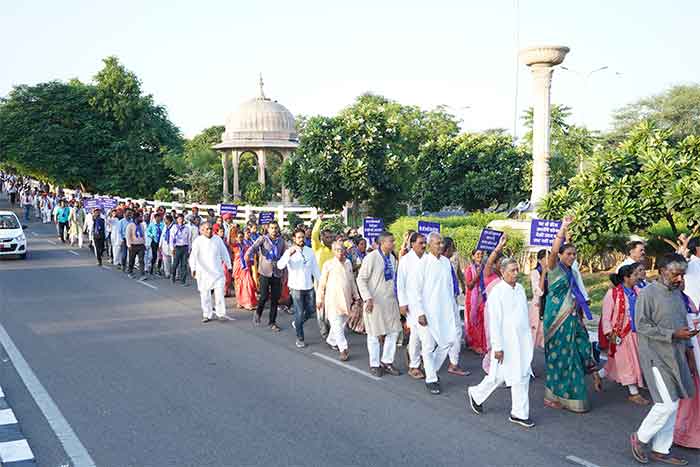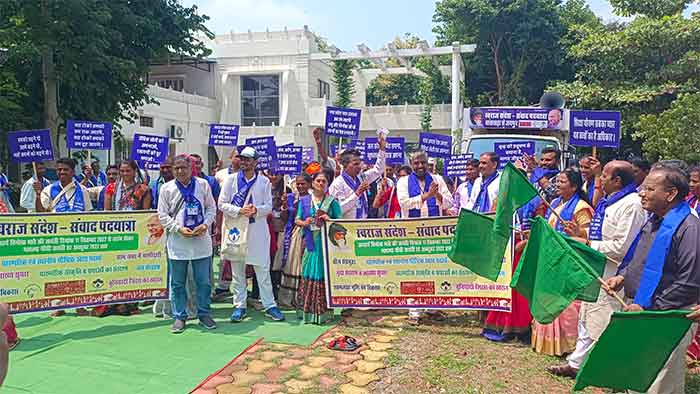
In a recent 21 day march from Banswara to Jaipur, a distance of over 500 km., members of tribal communities of South Rajasthan and neighboring areas asserted the need for important policy changes keeping in view the harm being caused by over-centralizing tendencies which are imposing priorities and policies that are far from the priorities and real needs as understood by these communities.
India’s constitution has provided important safeguards for scheduled tribes and this was strengthened by PESA law (Extension of Panchayati Raj to Scheduled Areas). While this law brought high hopes, its implementation was a disappointment in many ways. As a result, several tribal communities faced displacement or erosion of rights, while the feeling of existing development models being far removed from their real needs and aspirations have been even more widespread.
Looking for alternatives, several tribal communities in South Rajasthan started centering their alternative thinking on seeds, farming, food and nutrition, soil and water, education and childhood, forests and bio-diversity around the Gandhian concept of swaraj which during the freedom movement meant self-rule to most people but was now found very useful in assertions against over-centralizing tendencies that were resulting in serious problems for tribal communities. Rich traditions which had existed among tribal communities for a long time were very supportive of self-reliance, community ties, protection of indigenous seeds and the related bio-diversity but these have been harmed by the imposition of alien policies and attitudes. The resulting search for alternatives manifested in the concept of swaraj and several dialogues, facilitated by activists of a leading voluntary organization Vaagdhara, led to articulation of what swaraj means and signifies in present times in the more specific context of farming, food, seeds, nutrition, soil, water, forests, health, education, culture etc. It was felt that these ideas are likely to have a wider relevance and need to be discussed with a much larger number of people, ordinary villagers as well as scholars. Enriched and endorsed by such dialogues, this vision should then be translated into a set of demands for policy changes and placed before the government with wide endorsement of people and scholars involved in such issues.
These discussions finally culminated in the planning for a people’s march and dialogue centered in the concept of swaraj, to be facilitated by Vaagdhara . This march, it was planned, would inter-act with various rural communities (not just tribal ones) on the way from Banswara to Jaipur and meet elected representatives as well.
Over 200 members of tribal communities started on this march cum dialogue with high hopes. Each day they would wake up as early as around 3 a.m. with a view to getting an early start. They covered about 25 km per day and had meetings and inter-actions generally at two places.
Tribal farmers who were marching were surprised to know that several of their concerns were shared by other farmers in many villages. There was widespread concern over the adverse impacts of indiscriminate use of chemical fertilizers and pesticides. There was concern over the steady loss of several nutritious crops and foods, including but not confined to millets, or the loss of their health and medicinal benefits due to excessive agro-chemical inputs and loss of natural fertility of land. With increasing preoccupation with shorter-term gains, the base of sustainable farming in the form of soil and water was being eroded and depleted, raising serious concerns over sustainability of rural livelihoods.

While the march and its dialogues and inter-actions among village communities, farmers and marchers confirmed that such concerns were widespread (although local details and contexts may differ), on the positive side it was clear that there were thoughtful responses from various people, particularly farmers. Several of the marchers also had much to say regarding their best practices, as they had worked in a more systemic and stable way regarding this, and their display of a wide diversity of traditional seeds, along with comments on the importance and nitty-gritty of this work, was well-received by people.
It is very important to sensitize the upcoming generation on these issues and the marchers made it a point to visit schools along the way and speak to children and teachers. Students also took a keen interest in the diversity of seeds displayed. But what delighted children most was when the marchers stated that children should be involved in decision making in all issues concerning them, in families, schools and even gram sabhas ( village assemblies which are so far seen officially as assemblies of only village adults)! The marchers placed a vision of childhood which is free of exploitation and deprivation, in which all children get opportunities of good learning– learning which prepares them for many –sided opportunities without alienating them from their roots in such a way that with all their learning and skills they remain committed to the welfare of their community and strive to contribute to it when they grow up.
Another effort of the marchers was to keep meeting elected panchayat representatives and local officials along the way so that some of the good practices or the issues being discussed in the course of these dialogues can get their support as well, or at least they can be sensitized regarding these, to be more aware and thoughtful regarding such concerns.
When the marchers reached Jaipur on the 21st day, a meeting of several leading scholars and thinkers was organized to discuss the various issues raised in the course of the march. This helped the marchers to prepare a charter of demands relating to much greater emphasis on local/traditional seeds conservation and also involving government agencies in this, on soil and water conservation, on farming and food systems which are much more self-reliant, ecologically protective and closer to the ways nutrition needs of people have been met in more satisfactory and wholesome ways in the past, on protection of forests and creation of new forests based on diverse indigenous species, and even more broadly a thoughtful encouragement for those educational and cultural initiatives which can strengthen village communities for a more secure and integrative future in difficult times of climate change and adverse weather. This charter of demands was presented to the Chief Minister and the Governor, securing hope-giving assurances from the government ( the Rajasthan government has a better record than several state governments in terms of several promising initiatives) and on this optimistic note the marchers returned home to share several constructive ideas of the march with their communities.
Bharat Dogra is Honorary Convener, Campaign to Save Earth Now. His recent books include India’s Quest for Sustainable Farming and Healthy Food, Planet in Peril and A Day in 2071.











































